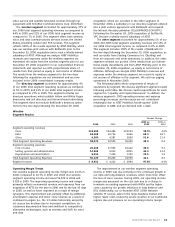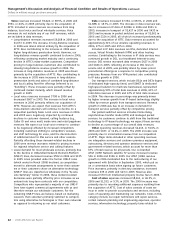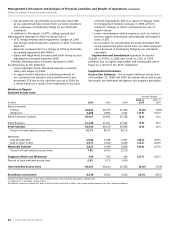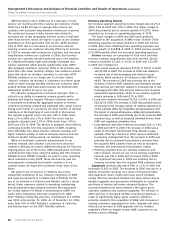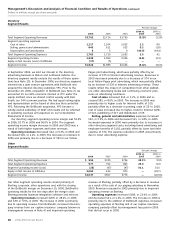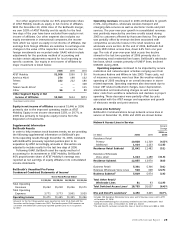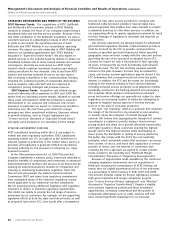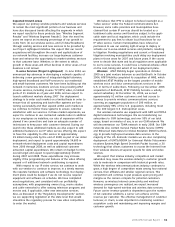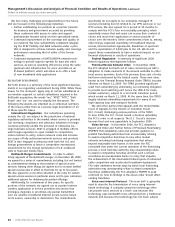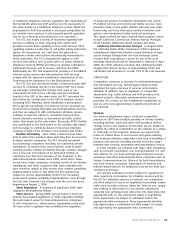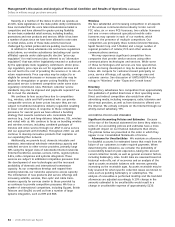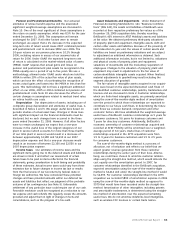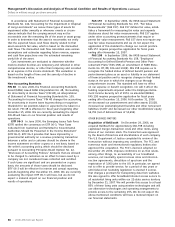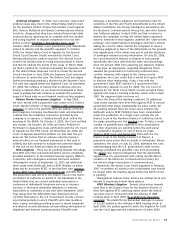AT&T Wireless 2006 Annual Report Download - page 29
Download and view the complete annual report
Please find page 29 of the 2006 AT&T Wireless annual report below. You can navigate through the pages in the report by either clicking on the pages listed below, or by using the keyword search tool below to find specific information within the annual report.
2006 AT&T Annual Report : :
27
Cost of services and equipment sales expenses increased
$669, or 4.7%, in 2006 and $6,776 in 2005. The increase in
2006 was primarily due to increases in network usage and
associated network system expansion. The increase in 2005
was primarily due to increased cost of services resulting from
the acquired AWE network. Cost of services includes integra-
tion costs, primarily for network integration, of $229 in 2006
compared to $195 in 2005. Cost of services in 2005 also
includes $97 in hurricane-related costs.
Cost of services increased $491, or 5.3%, in 2006 and $4,581
in 2005. Cost of services increased due to the following:
• Increases in network usage with a total system minutes-
of-use (MOU) increase of 20.6% in 2006 and more than
110% in 2005 related to the increase in customers.
Additionally, average MOU’s per customer increased 8.2%
in 2006 and 20.0% in 2005. The significant increase in
2005 was primarily due to the increase in subscribers
related to AT&T Mobility’s acquisition of AWE.
• Higher roaming and long-distance costs, partially offset
by a decline in reseller expenses in 2006. The reseller
decrease resulted from a decrease in minutes of use on the
T-Mobile network of more than 50% for 2006. In 2005, higher
roaming and long-distance costs and increased USF and
regulatory fees related to the increase in the customer base.
• Increased payments in 2005 to T-Mobile for the use of its
network in California and Nevada, as well as expenses
related to operating, maintaining and decommissioning
TDMA networks that duplicated GSM networks while
integrating the networks acquired from AWE.
Equipment sales expenses increased $178, or 3.5%, in 2006
and $2,195 in 2005. The increase in 2006 was due to in-
creased handset upgrades of 11.2% and an increase in the
average cost per upgrades and accessories sold, partially
offset by the decline in the average cost per handset sold to
new customers. The increase in 2005 was primarily due to
higher handset unit sales associated with the 46.1% increase
in gross customer additions in 2005, existing customers
upgrading their units and the continued migration of former
AWE customers to AT&T Mobility service offerings, which
required new handsets. Total equipment costs continue to be
higher than equipment revenues due to the sale of handsets
below cost to customers who committed to one-year or two-
year contracts or in connection with other promotions.
Selling, general and administrative expenses decreased
$200, or 1.7%, in 2006 and increased $4,298 in 2005.
The decline in 2006 was due to decreases in general and
administrative expenses of $296, partially offset by an
increase in selling expenses of $96. The increase in 2005
expenses was due to increases in general and administrative
expenses of $2,913, primarily due to the acquisition of AWE,
and selling expenses of $1,385 due to the increase in gross
customer additions previously mentioned.
The decline in selling, general and administrative expenses
in 2006 was due to the following:
• Decreases in billing and bad debt expense of $378
primarily due to fewer account write-offs and cost-
savings related to transitioning to one billing system.
• Decreases in other administrative expense of $108 due to
a decline in legal related expenses, lower employee costs
and employee-related benefits due to a decrease in the
number of employees, lower IT and other professional
services expense and a federal excise tax refund accrual.
• Decreases in customer service expense of $87 due
to a decline in the number of outsourced call center
professional services and lower billing expenses.
• Increases of $147 primarily related to increased prepaid
card replenishment costs and higher migration and
upgrade transaction costs.
• Increases in other expense of $130 due to higher
warranty, refurbishment and freight costs.
• Increases in selling expense of $96 due to an increase
in sales expense, partially offset by a decrease in net
commission expenses. The decline in net commission
expense was due to reductions in average activation and
agent branding expense, partially offset by an increase in
direct commission expense.
The increase in selling, general and administrative expenses
in 2005 was due to the following:
• Increases in customer service expense of $960 due to a
higher number of employees and employee-related
expenses related to the significant increase in customers
as well as customer retention and customer service
improvement initiatives.
• Increases in other administrative expense of $926
primarily due to incremental expenses associated with
the acquired AWE administrative functions.
• Increases in billing, bad debt and other customer
maintenance expense of $766 primarily due to the
significant increase in AT&T Mobility’s customer base.
• Increases in commission expense of $494 and advertising
and marketing expense of $429.
• Increases in sales expense of $462 primarily due to
increased sales personnel costs associated with the
acquired AWE sales force.
• Increases in upgrade commissions of $261 due to the
increased customer migration and handset upgrade
activity.
The expenses above also include integration costs of $123
in 2006 and $264 in 2005, such as employee-termination
costs, re-branding and advertising and customer service and
systems integration costs.
Depreciation and amortization expenses decreased $139,
or 2.1%, in 2006 and increased $3,498 in 2005.
Depreciation expense increased $310, or 6.4%, in 2006
primarily due to depreciation associated with the property,
plant and equipment related to ongoing capital spending for
our GSM network, partially offset by expense declines due
to equipment that had become fully depreciated in 2006.
Depreciation expense increased $2,249 in 2005 primarily due
to incremental depreciation associated with the property,
plant and equipment acquired in the AWE acquisition along
with depreciation related to AT&T Mobility’s expansion of its
GSM network and accelerated depreciation on certain
TDMA network and other network assets based on the
projected transition of network traffic to our GSM network.
The 2005 increase included $417 of integration costs.
Amortization expenses decreased $449, or 25.5%, in 2006
and increased $1,249 in 2005. The decline in 2006 was due to
declining amortization of the AWE customer contracts and other
intangible assets acquired, which are amortized using an
accelerated method of amortization. The increase in 2005 was
primarily due to a full year’s amortization of the AWE customer
contracts and other intangible assets acquired in October 2004.






